Cybercrime: A Comprehensive Analysis of Definition and Real-Life Cases
VerifiedAdded on 2022/09/18
|6
|2154
|25
Report
AI Summary
This report provides a comprehensive overview of cybercrime, starting with its definition as a wide range of non-violent offenses committed using digital technologies, including hacking, forgery, and copyright infringement. It explores various aspects of cybercrime, such as the anonymity afforded by digital technology, the global reach of these crimes, and the increasing vulnerability of online platforms. The report highlights real-life examples, including COVID-19 scams, threats over social media, and incidents involving hacked Facebook accounts, illustrating the diverse tactics employed by cybercriminals and the significant financial and psychological impacts of these crimes. It emphasizes the need for international cooperation, strict cybercrime laws, and individual awareness to prevent and mitigate the effects of cybercrime. The report concludes by stressing the importance of education and preventive measures such as strong passwords and anti-virus software to combat cyber threats.

Running head: CYBERCRIME
1
Cybercrime
Author’s Name
Institutional Affiliation
1
Cybercrime
Author’s Name
Institutional Affiliation
Paraphrase This Document
Need a fresh take? Get an instant paraphrase of this document with our AI Paraphraser
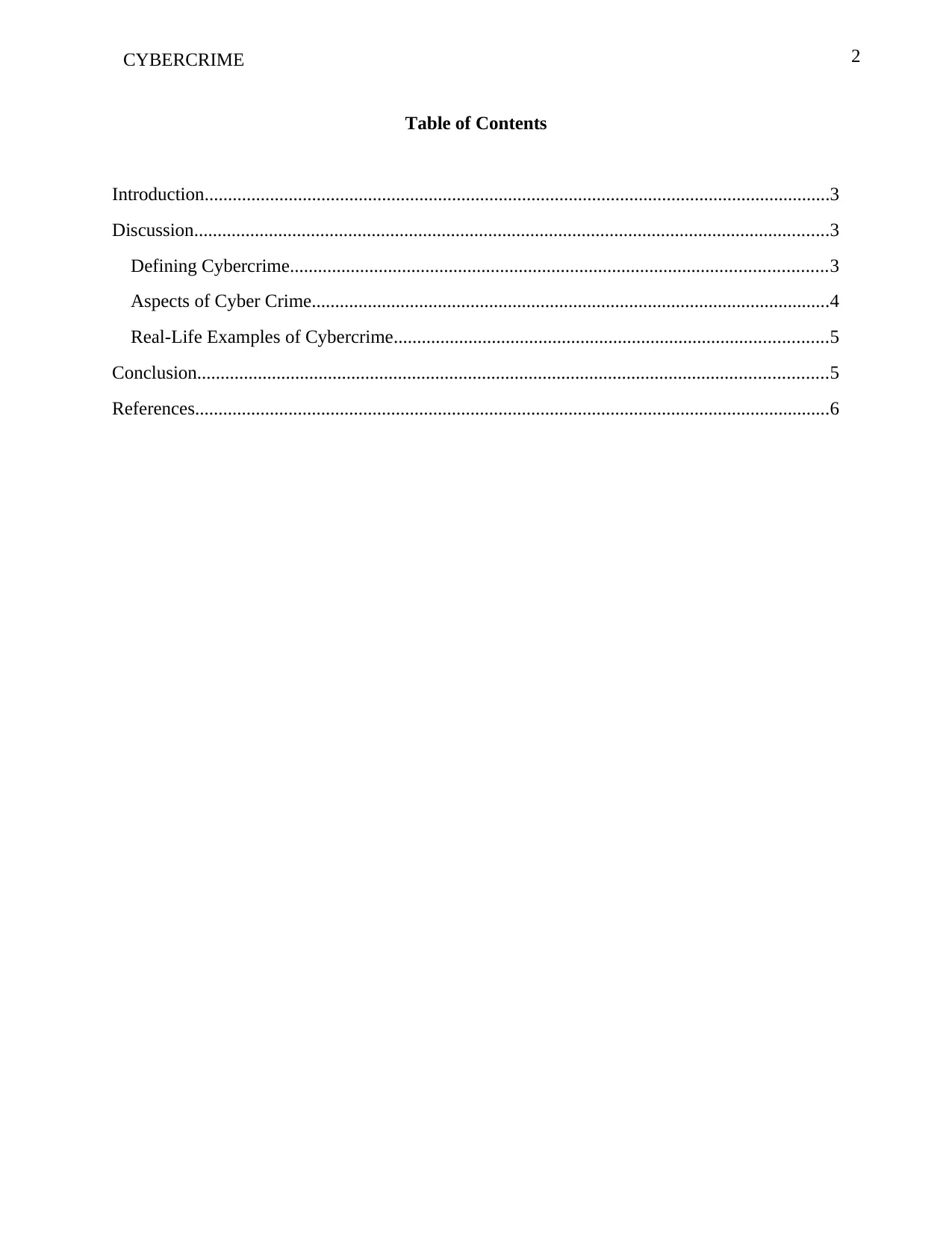
2CYBERCRIME
Table of Contents
Introduction......................................................................................................................................3
Discussion........................................................................................................................................3
Defining Cybercrime...................................................................................................................3
Aspects of Cyber Crime...............................................................................................................4
Real-Life Examples of Cybercrime.............................................................................................5
Conclusion.......................................................................................................................................5
References........................................................................................................................................6
Table of Contents
Introduction......................................................................................................................................3
Discussion........................................................................................................................................3
Defining Cybercrime...................................................................................................................3
Aspects of Cyber Crime...............................................................................................................4
Real-Life Examples of Cybercrime.............................................................................................5
Conclusion.......................................................................................................................................5
References........................................................................................................................................6
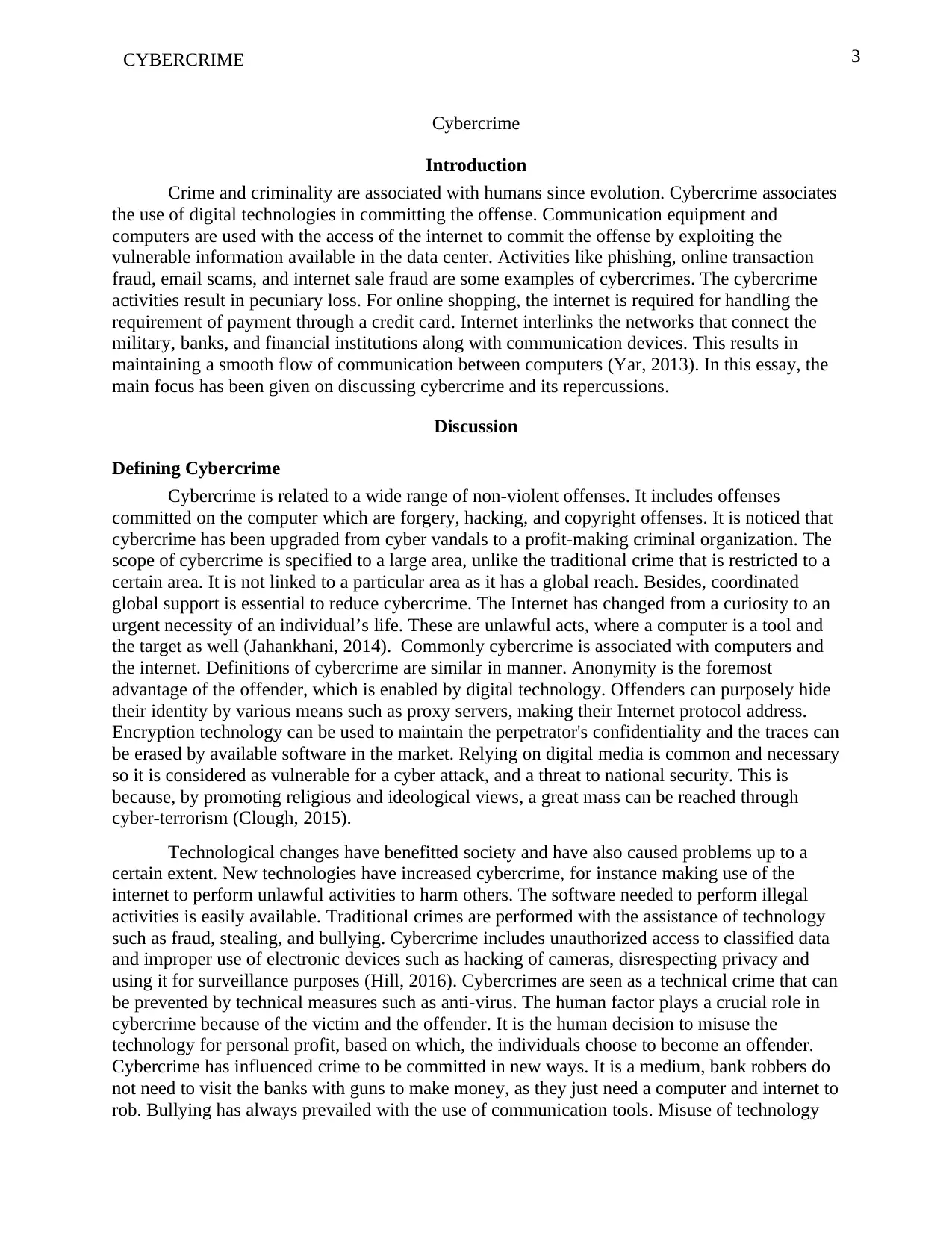
3CYBERCRIME
Cybercrime
Introduction
Crime and criminality are associated with humans since evolution. Cybercrime associates
the use of digital technologies in committing the offense. Communication equipment and
computers are used with the access of the internet to commit the offense by exploiting the
vulnerable information available in the data center. Activities like phishing, online transaction
fraud, email scams, and internet sale fraud are some examples of cybercrimes. The cybercrime
activities result in pecuniary loss. For online shopping, the internet is required for handling the
requirement of payment through a credit card. Internet interlinks the networks that connect the
military, banks, and financial institutions along with communication devices. This results in
maintaining a smooth flow of communication between computers (Yar, 2013). In this essay, the
main focus has been given on discussing cybercrime and its repercussions.
Discussion
Defining Cybercrime
Cybercrime is related to a wide range of non-violent offenses. It includes offenses
committed on the computer which are forgery, hacking, and copyright offenses. It is noticed that
cybercrime has been upgraded from cyber vandals to a profit-making criminal organization. The
scope of cybercrime is specified to a large area, unlike the traditional crime that is restricted to a
certain area. It is not linked to a particular area as it has a global reach. Besides, coordinated
global support is essential to reduce cybercrime. The Internet has changed from a curiosity to an
urgent necessity of an individual’s life. These are unlawful acts, where a computer is a tool and
the target as well (Jahankhani, 2014). Commonly cybercrime is associated with computers and
the internet. Definitions of cybercrime are similar in manner. Anonymity is the foremost
advantage of the offender, which is enabled by digital technology. Offenders can purposely hide
their identity by various means such as proxy servers, making their Internet protocol address.
Encryption technology can be used to maintain the perpetrator's confidentiality and the traces can
be erased by available software in the market. Relying on digital media is common and necessary
so it is considered as vulnerable for a cyber attack, and a threat to national security. This is
because, by promoting religious and ideological views, a great mass can be reached through
cyber-terrorism (Clough, 2015).
Technological changes have benefitted society and have also caused problems up to a
certain extent. New technologies have increased cybercrime, for instance making use of the
internet to perform unlawful activities to harm others. The software needed to perform illegal
activities is easily available. Traditional crimes are performed with the assistance of technology
such as fraud, stealing, and bullying. Cybercrime includes unauthorized access to classified data
and improper use of electronic devices such as hacking of cameras, disrespecting privacy and
using it for surveillance purposes (Hill, 2016). Cybercrimes are seen as a technical crime that can
be prevented by technical measures such as anti-virus. The human factor plays a crucial role in
cybercrime because of the victim and the offender. It is the human decision to misuse the
technology for personal profit, based on which, the individuals choose to become an offender.
Cybercrime has influenced crime to be committed in new ways. It is a medium, bank robbers do
not need to visit the banks with guns to make money, as they just need a computer and internet to
rob. Bullying has always prevailed with the use of communication tools. Misuse of technology
Cybercrime
Introduction
Crime and criminality are associated with humans since evolution. Cybercrime associates
the use of digital technologies in committing the offense. Communication equipment and
computers are used with the access of the internet to commit the offense by exploiting the
vulnerable information available in the data center. Activities like phishing, online transaction
fraud, email scams, and internet sale fraud are some examples of cybercrimes. The cybercrime
activities result in pecuniary loss. For online shopping, the internet is required for handling the
requirement of payment through a credit card. Internet interlinks the networks that connect the
military, banks, and financial institutions along with communication devices. This results in
maintaining a smooth flow of communication between computers (Yar, 2013). In this essay, the
main focus has been given on discussing cybercrime and its repercussions.
Discussion
Defining Cybercrime
Cybercrime is related to a wide range of non-violent offenses. It includes offenses
committed on the computer which are forgery, hacking, and copyright offenses. It is noticed that
cybercrime has been upgraded from cyber vandals to a profit-making criminal organization. The
scope of cybercrime is specified to a large area, unlike the traditional crime that is restricted to a
certain area. It is not linked to a particular area as it has a global reach. Besides, coordinated
global support is essential to reduce cybercrime. The Internet has changed from a curiosity to an
urgent necessity of an individual’s life. These are unlawful acts, where a computer is a tool and
the target as well (Jahankhani, 2014). Commonly cybercrime is associated with computers and
the internet. Definitions of cybercrime are similar in manner. Anonymity is the foremost
advantage of the offender, which is enabled by digital technology. Offenders can purposely hide
their identity by various means such as proxy servers, making their Internet protocol address.
Encryption technology can be used to maintain the perpetrator's confidentiality and the traces can
be erased by available software in the market. Relying on digital media is common and necessary
so it is considered as vulnerable for a cyber attack, and a threat to national security. This is
because, by promoting religious and ideological views, a great mass can be reached through
cyber-terrorism (Clough, 2015).
Technological changes have benefitted society and have also caused problems up to a
certain extent. New technologies have increased cybercrime, for instance making use of the
internet to perform unlawful activities to harm others. The software needed to perform illegal
activities is easily available. Traditional crimes are performed with the assistance of technology
such as fraud, stealing, and bullying. Cybercrime includes unauthorized access to classified data
and improper use of electronic devices such as hacking of cameras, disrespecting privacy and
using it for surveillance purposes (Hill, 2016). Cybercrimes are seen as a technical crime that can
be prevented by technical measures such as anti-virus. The human factor plays a crucial role in
cybercrime because of the victim and the offender. It is the human decision to misuse the
technology for personal profit, based on which, the individuals choose to become an offender.
Cybercrime has influenced crime to be committed in new ways. It is a medium, bank robbers do
not need to visit the banks with guns to make money, as they just need a computer and internet to
rob. Bullying has always prevailed with the use of communication tools. Misuse of technology
⊘ This is a preview!⊘
Do you want full access?
Subscribe today to unlock all pages.

Trusted by 1+ million students worldwide
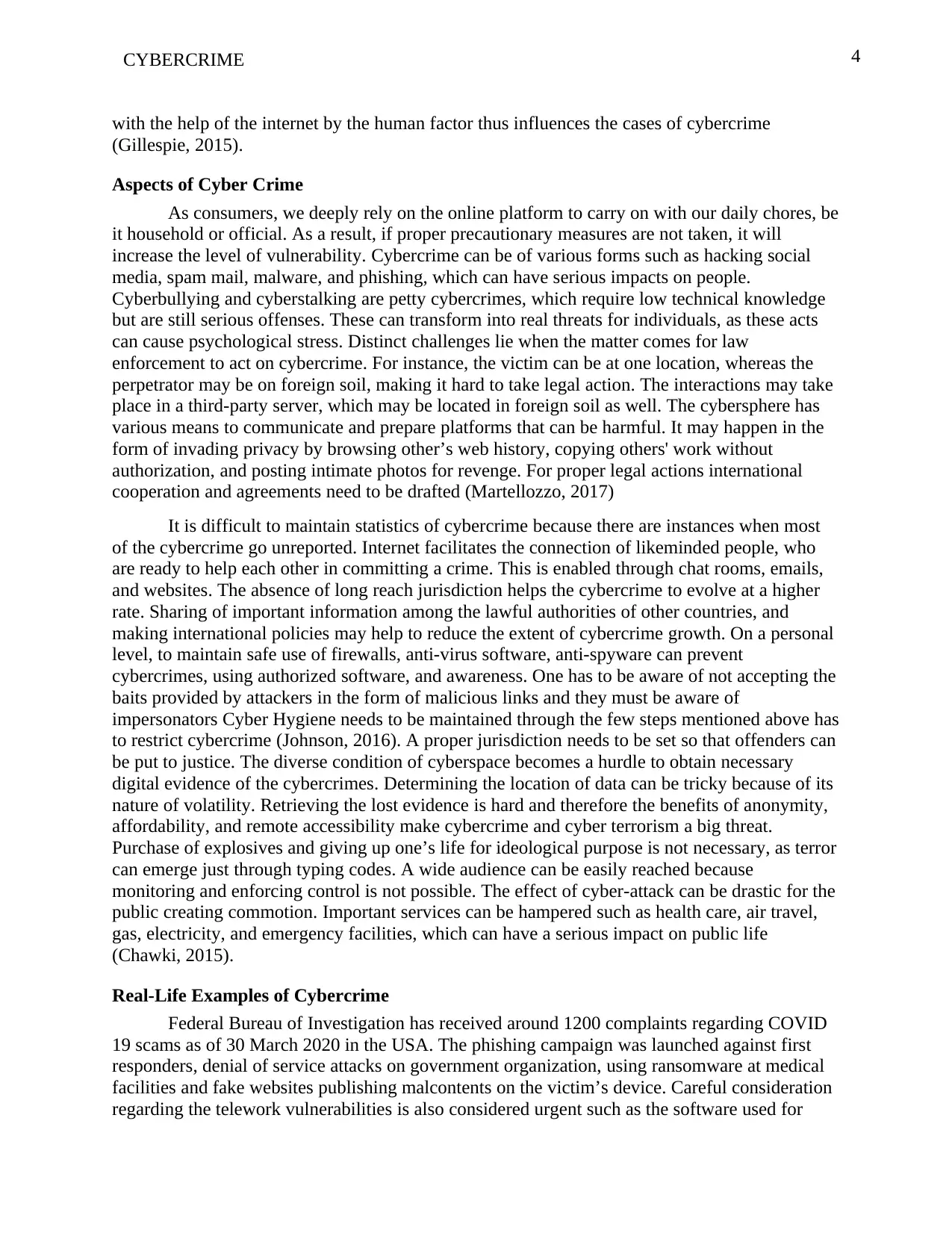
4CYBERCRIME
with the help of the internet by the human factor thus influences the cases of cybercrime
(Gillespie, 2015).
Aspects of Cyber Crime
As consumers, we deeply rely on the online platform to carry on with our daily chores, be
it household or official. As a result, if proper precautionary measures are not taken, it will
increase the level of vulnerability. Cybercrime can be of various forms such as hacking social
media, spam mail, malware, and phishing, which can have serious impacts on people.
Cyberbullying and cyberstalking are petty cybercrimes, which require low technical knowledge
but are still serious offenses. These can transform into real threats for individuals, as these acts
can cause psychological stress. Distinct challenges lie when the matter comes for law
enforcement to act on cybercrime. For instance, the victim can be at one location, whereas the
perpetrator may be on foreign soil, making it hard to take legal action. The interactions may take
place in a third-party server, which may be located in foreign soil as well. The cybersphere has
various means to communicate and prepare platforms that can be harmful. It may happen in the
form of invading privacy by browsing other’s web history, copying others' work without
authorization, and posting intimate photos for revenge. For proper legal actions international
cooperation and agreements need to be drafted (Martellozzo, 2017)
It is difficult to maintain statistics of cybercrime because there are instances when most
of the cybercrime go unreported. Internet facilitates the connection of likeminded people, who
are ready to help each other in committing a crime. This is enabled through chat rooms, emails,
and websites. The absence of long reach jurisdiction helps the cybercrime to evolve at a higher
rate. Sharing of important information among the lawful authorities of other countries, and
making international policies may help to reduce the extent of cybercrime growth. On a personal
level, to maintain safe use of firewalls, anti-virus software, anti-spyware can prevent
cybercrimes, using authorized software, and awareness. One has to be aware of not accepting the
baits provided by attackers in the form of malicious links and they must be aware of
impersonators Cyber Hygiene needs to be maintained through the few steps mentioned above has
to restrict cybercrime (Johnson, 2016). A proper jurisdiction needs to be set so that offenders can
be put to justice. The diverse condition of cyberspace becomes a hurdle to obtain necessary
digital evidence of the cybercrimes. Determining the location of data can be tricky because of its
nature of volatility. Retrieving the lost evidence is hard and therefore the benefits of anonymity,
affordability, and remote accessibility make cybercrime and cyber terrorism a big threat.
Purchase of explosives and giving up one’s life for ideological purpose is not necessary, as terror
can emerge just through typing codes. A wide audience can be easily reached because
monitoring and enforcing control is not possible. The effect of cyber-attack can be drastic for the
public creating commotion. Important services can be hampered such as health care, air travel,
gas, electricity, and emergency facilities, which can have a serious impact on public life
(Chawki, 2015).
Real-Life Examples of Cybercrime
Federal Bureau of Investigation has received around 1200 complaints regarding COVID
19 scams as of 30 March 2020 in the USA. The phishing campaign was launched against first
responders, denial of service attacks on government organization, using ransomware at medical
facilities and fake websites publishing malcontents on the victim’s device. Careful consideration
regarding the telework vulnerabilities is also considered urgent such as the software used for
with the help of the internet by the human factor thus influences the cases of cybercrime
(Gillespie, 2015).
Aspects of Cyber Crime
As consumers, we deeply rely on the online platform to carry on with our daily chores, be
it household or official. As a result, if proper precautionary measures are not taken, it will
increase the level of vulnerability. Cybercrime can be of various forms such as hacking social
media, spam mail, malware, and phishing, which can have serious impacts on people.
Cyberbullying and cyberstalking are petty cybercrimes, which require low technical knowledge
but are still serious offenses. These can transform into real threats for individuals, as these acts
can cause psychological stress. Distinct challenges lie when the matter comes for law
enforcement to act on cybercrime. For instance, the victim can be at one location, whereas the
perpetrator may be on foreign soil, making it hard to take legal action. The interactions may take
place in a third-party server, which may be located in foreign soil as well. The cybersphere has
various means to communicate and prepare platforms that can be harmful. It may happen in the
form of invading privacy by browsing other’s web history, copying others' work without
authorization, and posting intimate photos for revenge. For proper legal actions international
cooperation and agreements need to be drafted (Martellozzo, 2017)
It is difficult to maintain statistics of cybercrime because there are instances when most
of the cybercrime go unreported. Internet facilitates the connection of likeminded people, who
are ready to help each other in committing a crime. This is enabled through chat rooms, emails,
and websites. The absence of long reach jurisdiction helps the cybercrime to evolve at a higher
rate. Sharing of important information among the lawful authorities of other countries, and
making international policies may help to reduce the extent of cybercrime growth. On a personal
level, to maintain safe use of firewalls, anti-virus software, anti-spyware can prevent
cybercrimes, using authorized software, and awareness. One has to be aware of not accepting the
baits provided by attackers in the form of malicious links and they must be aware of
impersonators Cyber Hygiene needs to be maintained through the few steps mentioned above has
to restrict cybercrime (Johnson, 2016). A proper jurisdiction needs to be set so that offenders can
be put to justice. The diverse condition of cyberspace becomes a hurdle to obtain necessary
digital evidence of the cybercrimes. Determining the location of data can be tricky because of its
nature of volatility. Retrieving the lost evidence is hard and therefore the benefits of anonymity,
affordability, and remote accessibility make cybercrime and cyber terrorism a big threat.
Purchase of explosives and giving up one’s life for ideological purpose is not necessary, as terror
can emerge just through typing codes. A wide audience can be easily reached because
monitoring and enforcing control is not possible. The effect of cyber-attack can be drastic for the
public creating commotion. Important services can be hampered such as health care, air travel,
gas, electricity, and emergency facilities, which can have a serious impact on public life
(Chawki, 2015).
Real-Life Examples of Cybercrime
Federal Bureau of Investigation has received around 1200 complaints regarding COVID
19 scams as of 30 March 2020 in the USA. The phishing campaign was launched against first
responders, denial of service attacks on government organization, using ransomware at medical
facilities and fake websites publishing malcontents on the victim’s device. Careful consideration
regarding the telework vulnerabilities is also considered urgent such as the software used for
Paraphrase This Document
Need a fresh take? Get an instant paraphrase of this document with our AI Paraphraser
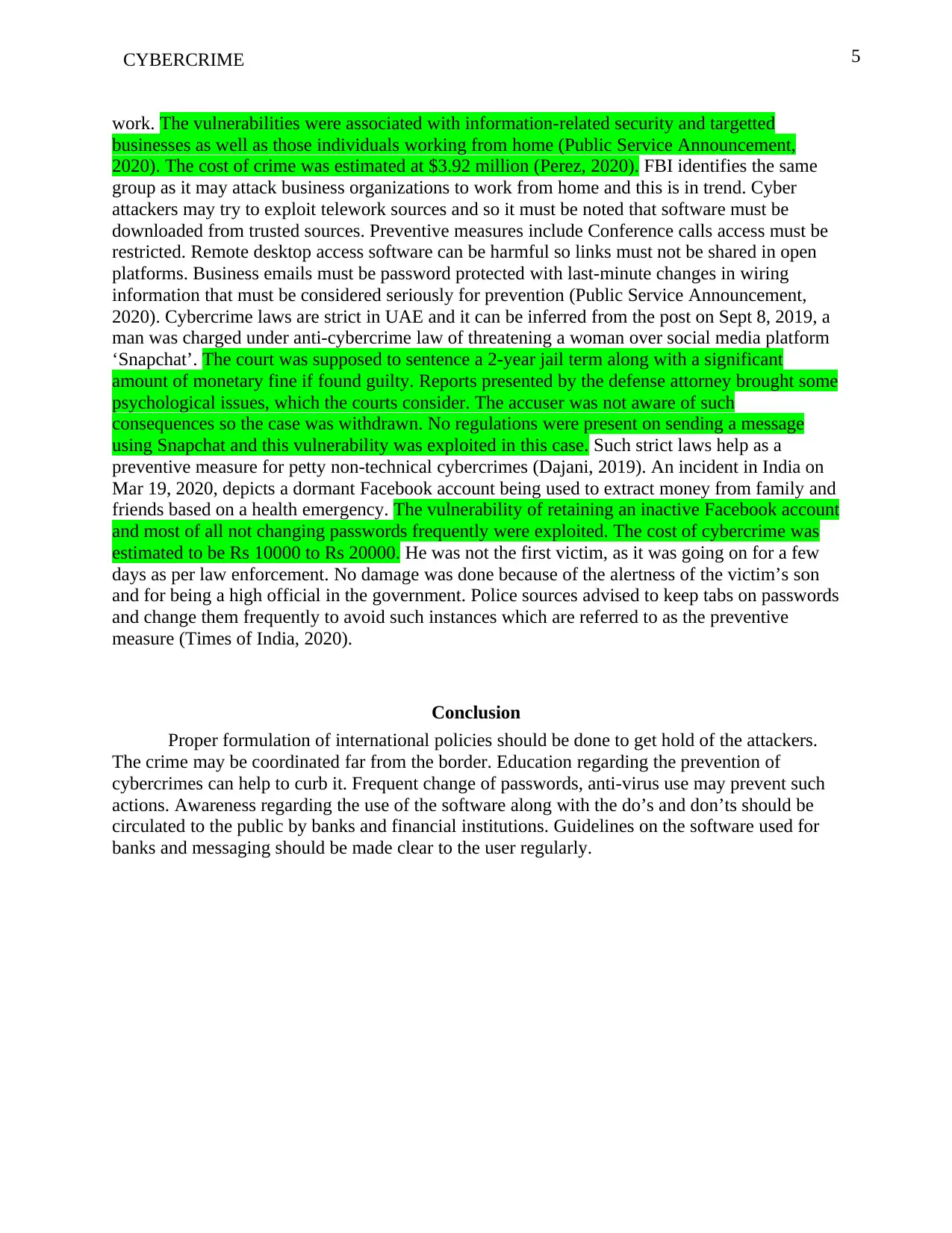
5CYBERCRIME
work. The vulnerabilities were associated with information-related security and targetted
businesses as well as those individuals working from home (Public Service Announcement,
2020). The cost of crime was estimated at $3.92 million (Perez, 2020). FBI identifies the same
group as it may attack business organizations to work from home and this is in trend. Cyber
attackers may try to exploit telework sources and so it must be noted that software must be
downloaded from trusted sources. Preventive measures include Conference calls access must be
restricted. Remote desktop access software can be harmful so links must not be shared in open
platforms. Business emails must be password protected with last-minute changes in wiring
information that must be considered seriously for prevention (Public Service Announcement,
2020). Cybercrime laws are strict in UAE and it can be inferred from the post on Sept 8, 2019, a
man was charged under anti-cybercrime law of threatening a woman over social media platform
‘Snapchat’. The court was supposed to sentence a 2-year jail term along with a significant
amount of monetary fine if found guilty. Reports presented by the defense attorney brought some
psychological issues, which the courts consider. The accuser was not aware of such
consequences so the case was withdrawn. No regulations were present on sending a message
using Snapchat and this vulnerability was exploited in this case. Such strict laws help as a
preventive measure for petty non-technical cybercrimes (Dajani, 2019). An incident in India on
Mar 19, 2020, depicts a dormant Facebook account being used to extract money from family and
friends based on a health emergency. The vulnerability of retaining an inactive Facebook account
and most of all not changing passwords frequently were exploited. The cost of cybercrime was
estimated to be Rs 10000 to Rs 20000. He was not the first victim, as it was going on for a few
days as per law enforcement. No damage was done because of the alertness of the victim’s son
and for being a high official in the government. Police sources advised to keep tabs on passwords
and change them frequently to avoid such instances which are referred to as the preventive
measure (Times of India, 2020).
Conclusion
Proper formulation of international policies should be done to get hold of the attackers.
The crime may be coordinated far from the border. Education regarding the prevention of
cybercrimes can help to curb it. Frequent change of passwords, anti-virus use may prevent such
actions. Awareness regarding the use of the software along with the do’s and don’ts should be
circulated to the public by banks and financial institutions. Guidelines on the software used for
banks and messaging should be made clear to the user regularly.
work. The vulnerabilities were associated with information-related security and targetted
businesses as well as those individuals working from home (Public Service Announcement,
2020). The cost of crime was estimated at $3.92 million (Perez, 2020). FBI identifies the same
group as it may attack business organizations to work from home and this is in trend. Cyber
attackers may try to exploit telework sources and so it must be noted that software must be
downloaded from trusted sources. Preventive measures include Conference calls access must be
restricted. Remote desktop access software can be harmful so links must not be shared in open
platforms. Business emails must be password protected with last-minute changes in wiring
information that must be considered seriously for prevention (Public Service Announcement,
2020). Cybercrime laws are strict in UAE and it can be inferred from the post on Sept 8, 2019, a
man was charged under anti-cybercrime law of threatening a woman over social media platform
‘Snapchat’. The court was supposed to sentence a 2-year jail term along with a significant
amount of monetary fine if found guilty. Reports presented by the defense attorney brought some
psychological issues, which the courts consider. The accuser was not aware of such
consequences so the case was withdrawn. No regulations were present on sending a message
using Snapchat and this vulnerability was exploited in this case. Such strict laws help as a
preventive measure for petty non-technical cybercrimes (Dajani, 2019). An incident in India on
Mar 19, 2020, depicts a dormant Facebook account being used to extract money from family and
friends based on a health emergency. The vulnerability of retaining an inactive Facebook account
and most of all not changing passwords frequently were exploited. The cost of cybercrime was
estimated to be Rs 10000 to Rs 20000. He was not the first victim, as it was going on for a few
days as per law enforcement. No damage was done because of the alertness of the victim’s son
and for being a high official in the government. Police sources advised to keep tabs on passwords
and change them frequently to avoid such instances which are referred to as the preventive
measure (Times of India, 2020).
Conclusion
Proper formulation of international policies should be done to get hold of the attackers.
The crime may be coordinated far from the border. Education regarding the prevention of
cybercrimes can help to curb it. Frequent change of passwords, anti-virus use may prevent such
actions. Awareness regarding the use of the software along with the do’s and don’ts should be
circulated to the public by banks and financial institutions. Guidelines on the software used for
banks and messaging should be made clear to the user regularly.
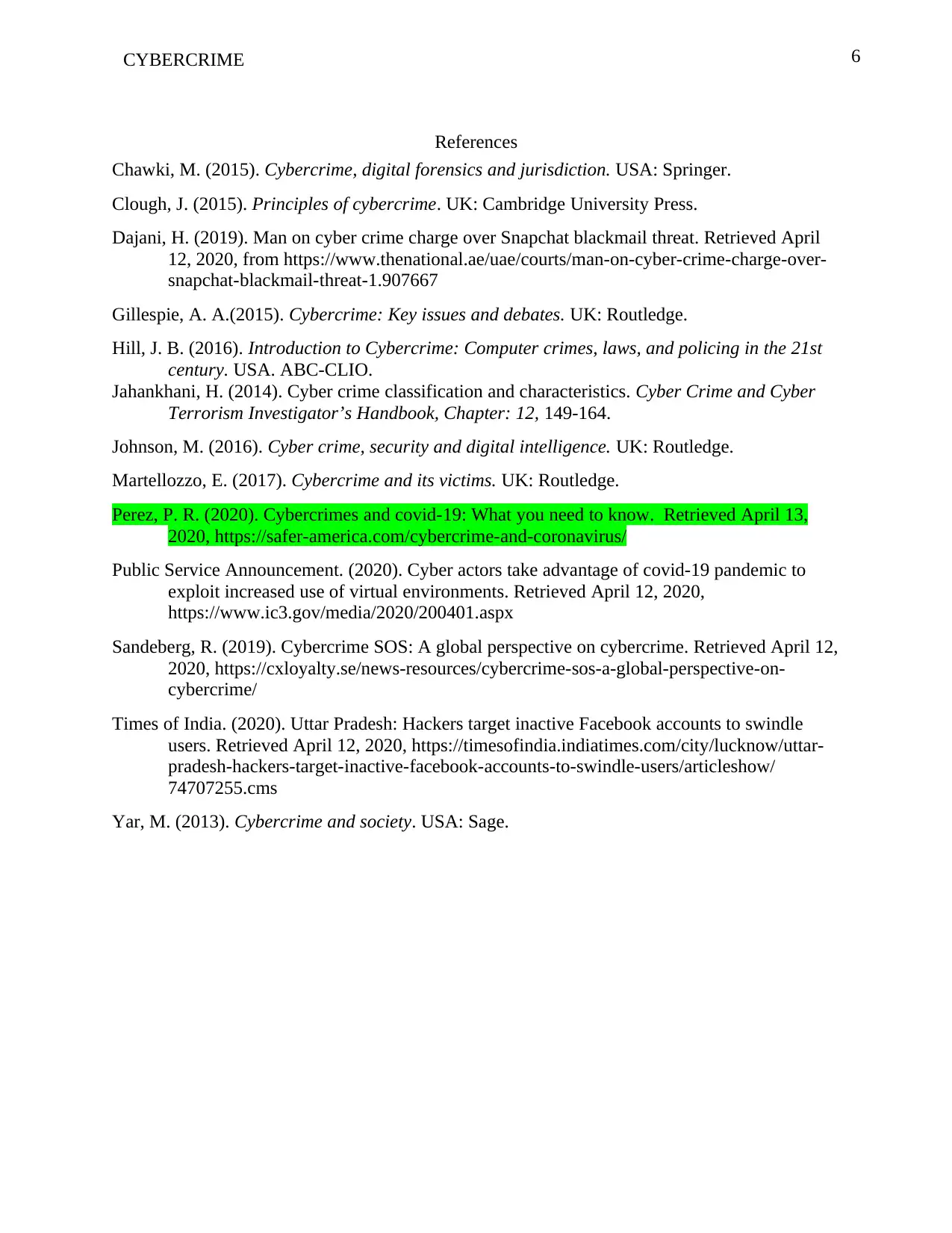
6CYBERCRIME
References
Chawki, M. (2015). Cybercrime, digital forensics and jurisdiction. USA: Springer.
Clough, J. (2015). Principles of cybercrime. UK: Cambridge University Press.
Dajani, H. (2019). Man on cyber crime charge over Snapchat blackmail threat. Retrieved April
12, 2020, from https://www.thenational.ae/uae/courts/man-on-cyber-crime-charge-over-
snapchat-blackmail-threat-1.907667
Gillespie, A. A.(2015). Cybercrime: Key issues and debates. UK: Routledge.
Hill, J. B. (2016). Introduction to Cybercrime: Computer crimes, laws, and policing in the 21st
century. USA. ABC-CLIO.
Jahankhani, H. (2014). Cyber crime classification and characteristics. Cyber Crime and Cyber
Terrorism Investigator’s Handbook, Chapter: 12, 149-164.
Johnson, M. (2016). Cyber crime, security and digital intelligence. UK: Routledge.
Martellozzo, E. (2017). Cybercrime and its victims. UK: Routledge.
Perez, P. R. (2020). Cybercrimes and covid-19: What you need to know. Retrieved April 13,
2020, https://safer-america.com/cybercrime-and-coronavirus/
Public Service Announcement. (2020). Cyber actors take advantage of covid-19 pandemic to
exploit increased use of virtual environments. Retrieved April 12, 2020,
https://www.ic3.gov/media/2020/200401.aspx
Sandeberg, R. (2019). Cybercrime SOS: A global perspective on cybercrime. Retrieved April 12,
2020, https://cxloyalty.se/news-resources/cybercrime-sos-a-global-perspective-on-
cybercrime/
Times of India. (2020). Uttar Pradesh: Hackers target inactive Facebook accounts to swindle
users. Retrieved April 12, 2020, https://timesofindia.indiatimes.com/city/lucknow/uttar-
pradesh-hackers-target-inactive-facebook-accounts-to-swindle-users/articleshow/
74707255.cms
Yar, M. (2013). Cybercrime and society. USA: Sage.
References
Chawki, M. (2015). Cybercrime, digital forensics and jurisdiction. USA: Springer.
Clough, J. (2015). Principles of cybercrime. UK: Cambridge University Press.
Dajani, H. (2019). Man on cyber crime charge over Snapchat blackmail threat. Retrieved April
12, 2020, from https://www.thenational.ae/uae/courts/man-on-cyber-crime-charge-over-
snapchat-blackmail-threat-1.907667
Gillespie, A. A.(2015). Cybercrime: Key issues and debates. UK: Routledge.
Hill, J. B. (2016). Introduction to Cybercrime: Computer crimes, laws, and policing in the 21st
century. USA. ABC-CLIO.
Jahankhani, H. (2014). Cyber crime classification and characteristics. Cyber Crime and Cyber
Terrorism Investigator’s Handbook, Chapter: 12, 149-164.
Johnson, M. (2016). Cyber crime, security and digital intelligence. UK: Routledge.
Martellozzo, E. (2017). Cybercrime and its victims. UK: Routledge.
Perez, P. R. (2020). Cybercrimes and covid-19: What you need to know. Retrieved April 13,
2020, https://safer-america.com/cybercrime-and-coronavirus/
Public Service Announcement. (2020). Cyber actors take advantage of covid-19 pandemic to
exploit increased use of virtual environments. Retrieved April 12, 2020,
https://www.ic3.gov/media/2020/200401.aspx
Sandeberg, R. (2019). Cybercrime SOS: A global perspective on cybercrime. Retrieved April 12,
2020, https://cxloyalty.se/news-resources/cybercrime-sos-a-global-perspective-on-
cybercrime/
Times of India. (2020). Uttar Pradesh: Hackers target inactive Facebook accounts to swindle
users. Retrieved April 12, 2020, https://timesofindia.indiatimes.com/city/lucknow/uttar-
pradesh-hackers-target-inactive-facebook-accounts-to-swindle-users/articleshow/
74707255.cms
Yar, M. (2013). Cybercrime and society. USA: Sage.
⊘ This is a preview!⊘
Do you want full access?
Subscribe today to unlock all pages.

Trusted by 1+ million students worldwide
1 out of 6
Related Documents
Your All-in-One AI-Powered Toolkit for Academic Success.
+13062052269
info@desklib.com
Available 24*7 on WhatsApp / Email
![[object Object]](/_next/static/media/star-bottom.7253800d.svg)
Unlock your academic potential
Copyright © 2020–2025 A2Z Services. All Rights Reserved. Developed and managed by ZUCOL.





